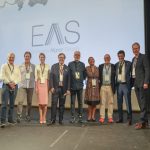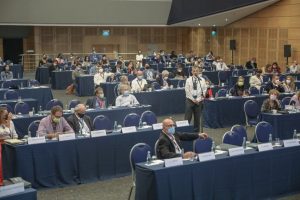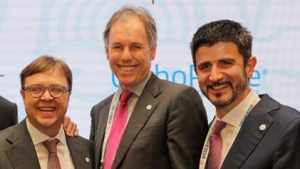The European Aligner Society (EAS) recently held its 2020 Autumn Meeting to continue to explore the perpetual advances in technologies and techniques in aligner orthodontics. The meeting, which took a virtual format to meet the needs of these challenging times, was moderated by EAS President Alain Souchet and Scientific Director Tommaso Castroflorio. It comprised three plenary sessions with speakers presenting the latest findings and experiences of aligner therapy. These can be watched on-demand here: https://www.eas-aligners.com/virtual-meeting-november-28-2020/.
As befitting a European organisation, the lectures were delivered by an International line-up of expert speakers, and attracted 207 delegates from Europe, North and South America, the Near and Far East and the Mediterranean countries. In the space of a day, delegates were taken on a world tour, taking in the latest orthodontic expertise without the need for a passport.
The global excursion started in Greece with Dr Gina Theodoridis who was one of the first Invisalign certified doctors and has been treating with aligners for almost twenty years. She is currently a Diamond provider and an Invisalign speaker. Dr Theodoridis’ lecture examined the factors and biomechanical concepts which affect the effectiveness of distalising the posterior teeth with aligners, and explored the realistic outcomes which can be achieved in such circumstances. In the two cases she presented, she concluded that the 50% sequential distalisation protocol was the most predictable and that posterior distalisation in the mandibular arch is a predictable option with aligners.
Traveling (digitally) from Europe to Japan where Dr John Kaku addressed he meeting. Dr Kaku obtained his Orthodontic Certificate and MSD degree from Boston University and is an Instructor at the Japanese Academy of Non-Extraction Orthodontics. For the EAS meeting, Dr Kaku took delegates on a tour of his practice to show them ‘How to have successful Invisalign First cases and management amongst team’. The presentation demonstrated the whole patient journey at his private practice, SuperSmile International Orthodontic Office, highlighting how involving a well-trained team and the right digital tools contributed to the success of the practice.
Back to Europe where the Vice-President of the Portuguese Aligner Society (SPAD) Dr Pedro Monteiro expanded on the changing orthodontic landscape and the behavioural shift amongst consumers. Dr Monteiro highlighted the importance of reinventing the patient journey using artificial intelligence and tele-dentistry in the virtual era and the need for building a virtual practice for what is not just the post Covid era, but the new reality. As he commented: “Virtual dentistry is a way of wowing your patients with outstanding service they cannot get elsewhere, it offers convenience, it also gives the patient an estimated treatment time and cost before any firm commitment is needed from them.”
Dr Rafi Romano has a private exclusively orthodontic practice in Tel Aviv, Israel, from where he delivered his lecture. Dr Romano’s emphasis on adult and aesthetic orthodontics, using state-of-the-art technologies was the focus of his session entitled ‘Optimise your aligner treatment utilising outcome simulation and progress assessment tools’. Dr Romano’s lecture focused on chairside tools which help orthodontists visualise, discuss and predict treatment options before beginning treatment and, later on, to assess the progress and fine-tune the treatment to maximise efficiency, shorten back-and-forth and the need for additional aligners. He explained how he uses the iTero Outcome Simulator and progress assessment tool features and artificial intelligence in order to make his work easier and more predictable. Dr Romano concluded that the tools you have today are not what you will have tomorrow as artificial intelligence algorithms are perpetually improving, and will give even better guidance about making the best tooth movements using clear aligners.
From Israel to Lithuania where Dr Dalia Latkauskiene is a Diamond II Invisalign provider. She practises in multidisciplinary orthodontic clinics and gives module courses on aligners based on basic principles of orthodontic biomechanics. At the EAS meeting Dr Latkauskiene presented on the topic of asymmetries in aligner treatment. If not properly diagnosed, slight asymmetries tend to be revealed throughout orthodontic treatment, thereby extending treatment time and hindering final outcomes. For correcting or reducing asymmetries, clinicians may choose asymmetrical dentoalveolar or skeletal mechanics, asymmetrical extractions or surgical interventions. Multidisciplinary treatments prove very useful to help solve dentoalveolar asymmetries. Aesthetic improvements of a dental nature and gingival outlines are required in deviated smiles, or frontal tipping of the occlusal plane. Working on pink and white aesthetic patterns may reduce dentoalveolar asymmetries and increase patient’s satisfaction. Dr Latkauskiene presented different plans of aligner treatment for dentoalveolar and skeletal asymmetries and advised her peers to be cautious with asymmetries of skeletal growth when treating children.
As she commented “We need to understand dentoalveolar asymmetries and adaptations, and how they reflect on facial soft tissues. We also have to be careful of TMJs and how they are approached, especially with aligners, both in children and adults, especially as aligners disengage the bite so that the teeth don’t bite together.”
Next to the USA to meet John Morton who has had a forty-year career in orthodontic biomechanics and is Senior Technology Fellow for Align Technology. He discussed the Invisalign SmartForce features, SmartTrack material and SmartStage technology which together provide the optimised progression of tooth movements, reduce unwanted interference and increase the predictability of Invisalign treatment. The importance of using the principles of biomechanics when planning treatments with aligners was highlighted by John who advised his peers that they need to investigate the anchorage capabilities of aligners, control the active and the reactive units and trust that the combination of SmartForce, SmartTrack and SmartStage are powerful enough to treat very complex cases with the Invisalign system.
Dr Sandra Tai from Canada has been an Invisalign certified orthodontist since 2000 and is currently an Invisalign Diamond Plus Provider. She is also the author of the most recent textbook on clear aligners called “Clear Aligner Technique”. Dr Tai’s presentation looked at the results of a research study completed at the University of British Columbia comparing skeletal, dental and soft tissue effects of Class II malocclusions treated with Invisalign with Mandibular Advancement compared with Twin Block functional appliances.
According to Dr Tai, both the twin block appliance and the Invisalign MA feature may be considered appropriate treatment alternatives when considering treatment options for class II, growing, retrognathic patients. The Invisalign system with MA showed a significant difference over twin block patients in increase in SNB and also offered better control on lower incisor inclination, and better vertical control of lower incisor position.
Dr Tai stated: “I was the twin block queen. When clear aligners first came out in year 2000, many of us thought of clear aligners as an appliance for class I minor crowding with a lot of IPR. In 20 years, clear aligner technology has evolved significantly. Never in my wildest dreams did I think I would be able to do growth modification for class II patients with a clear aligner appliance. I now believe that the Invisalign treatment with MA represents a ground breaking evolutionary leap forward for the field of clear aligner technology and for orthodontics. The future is digital and the future is clear”.
From North America to South where Dr Tomas Salazar from Chile presented ‘In office aligner workflow’ underlining that clear aligners have their place in an orthodontic clinical practice. He showcased the importance of the digital workflow in the treatment of malocclusions as it gives the exact information of how much and when each tooth will move. He concluded that aligners are the most individualised prescription ever created and looked at the option of fabricating them in clinic as a cost-effective and predictable process.
Dr Antonino Secchi from the USA received the 2005 David C. Hamilton Orthodontic Research Award from the Pennsylvania Association of Orthodontists (PAO), and the 2010 and 2013 Outstanding Teacher Awards from the Department of Orthodontics of the University of Pennsylvania. Dr. Secchi is the founder of the “Complete Clinical Orthodontics System” (CCO System™) and the Secchi Institute™, which provides continuing education for orthodontists in the USA and throughout the world. Dr Secchi presented Dentsply Sirona: The SureSmile Advantage. He advised that SureSmile assures the clinician has total control and predictability in their orthodontic treatment options. During this presentation Dr Secchi presented the principal advantages of SureSmile Aligner Therapy and illustrated its benefits with completed cases. He suggested that “SureSmile is a powerful cloud base software solution that provides accuracy, tremendous versatility, as well as superb control for clear aligner cases”.
The delegate feedback was unequivocally favourable, with testimonies including: “Congratulations on putting on a marvellous program. The past six months I have logged into a number of webinars from different organisations including two dental schools and a major Wall Street investment bank. In my opinion, you exceeded or were on par with all of them.” – Dr Barry Winnick (USA)
“I wish to thank you again for affording me the opportunity to present on this distinguished platform yesterday. There is no doubt that you are doing remarkable work for us doctors and you have created the most objective and informative Society.” – Dr Rafi Romano (Israel)
“I was so excited to watch the virtual meeting. I missed a few of the events because of the time. Glad the presentations are available later to watch” – Prof. Rooz Khosravi (USA)
For those, like Professor Khosravi, who would like to watch the lectures in their own time it is possible to do so by visiting https://www.eas-aligners.com/virtual-meeting-november-28-2020/, scrolling down to “Detailed Program” and underneath each presentation title there is an icon with “Recorded Video: Watch video”. Click to watch as many times as you wish.
At the conclusion of the EAS Virtual Meeting, The Executive Secretary of the European Aligner Society Dr Leslie Joffe updated delegates about the EAS’ 3rd Congress in Malta which is scheduled for 25th – 27th March 2021, but of course is subject to the prevailing health and travel guidelines. He advised that it would be a good idea to visit www.eas-aligners.com for more information and updates. It is also possible to renew Society membership and benefit from reduced Congress booking rates on the site.












